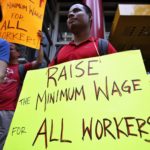WASHINGTON, D.C. — Minimum Wage Workers’ Equal Pay Day, the day that marks how many additional days into the new year a minimum-wage worker must work to earn the same amount she or he did in 2009, when the federal minimum wage was last increased. According to an analsis from the Center of American Progress, a full-time worker earning $7.25 per hour in 2018 would need to work an extra 41 days—more than eight additional working weeks—just to take home the same pay as in 2009. A full-time minimum-wage worker will lose almost $2,370 in purchasing power—more than 47 times the average tax cut the same worker can expect to temporarily receive from the congressional Republican tax law.
days into the new year a minimum-wage worker must work to earn the same amount she or he did in 2009, when the federal minimum wage was last increased. According to an analsis from the Center of American Progress, a full-time worker earning $7.25 per hour in 2018 would need to work an extra 41 days—more than eight additional working weeks—just to take home the same pay as in 2009. A full-time minimum-wage worker will lose almost $2,370 in purchasing power—more than 47 times the average tax cut the same worker can expect to temporarily receive from the congressional Republican tax law.
“Even while rising rents have pushed up the cost of living across the country, the federal minimum wage has stayed flat for nearly a decade, forcing people to work longer hours and take on extra jobs just to keep up,” said Rep. Keith Ellison (D-MN), Vice Chair of the Congressional Progressive Caucus and sponsor of the Pay Workers a Living Wage Act. “At a time when CEOs are taking home record bonuses, that is an unconscionable failure of our government. It is past time for those in Congress to stop listening to corporate donors, and start listening to movements like the Fight for $15 by establishing a nationwide living wage to make a real difference in the lives of working people.”
As the minimum wage has lost value, more and more minimum-wage workers now need to turn to programs like Medicaid and nutrition assistance to make ends meet. But instead of raising the poverty-level minimum wage, President Donald Trump and his colleagues in Congress are kicking workers while they’re down. Federal cuts to vital programs are continuing.
For every year that Congress fails to raise the nation’s minimum wage above the poverty wage of $7.25 per hour, inflation will continue to erode low-wage workers’ pay, pushing Minimum Wage Workers’ Equal Pay Day later into the new year.



